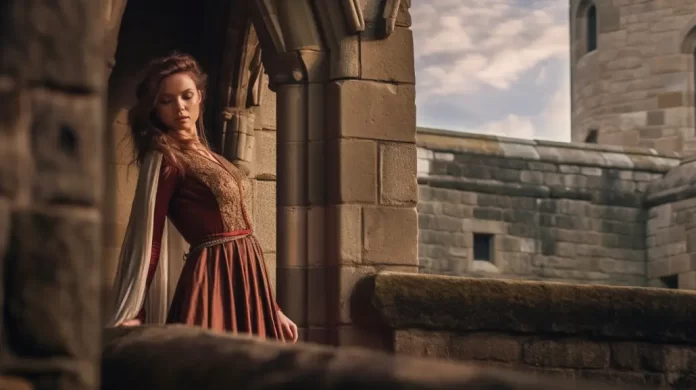Let’s throw on our imaginative cloaks, ladies, and time travel to the Middle Ages. Why? Because there’s a rich tapestry of medieval women’s fashion that remains unexplored, shrouded in the mists of time. Buckle up as we unveil the mystery and take an exciting journey through medieval women’s fashion. We promise a world of woolen kirtles, sumptuous surcoats, and headdresses that make a statement.
Decoding Medieval Women’s Fashion
Contrary to popular belief, medieval women’s fashion wasn’t just about long, flowing dresses in drab colors. The Middle Ages, spanning from the 5th to the 15th century, saw a plethora of fashion trends. Ranging from simple, pragmatic attires for the peasant class to extravagantly ornamented dresses for the nobility, medieval women’s fashion was as varied as the women who wore them.
Let’s step into the life of a medieval peasant woman, shall we? Imagine you’re a lady living in a small rural hamlet, tending to your chickens. Your outfit? A simple tunic, perhaps made from wool or linen. The colors might be muted and the design basic, but practicality is your fashion statement. This is medieval women’s fashion at its most functional.
Now, let’s juxtapose that with the royal courts. A noblewoman’s attire reflected her high societal standing. She wore a gown with a fitted bodice and a voluminous skirt, usually made from rich fabrics like silk or velvet, and often fur-lined for added warmth and luxury. Colors? Rich and vibrant, of course, because only the wealthy could afford expensive dyes.
Key Elements of Medieval Women’s Fashion
The dynamic nature of medieval women’s fashion is evident in its evolving styles, which reflected societal changes, geographical influences, and even political climates. Yet, some key elements remained quintessential throughout this era.
The Kirtle: The Medieval Go-to Dress
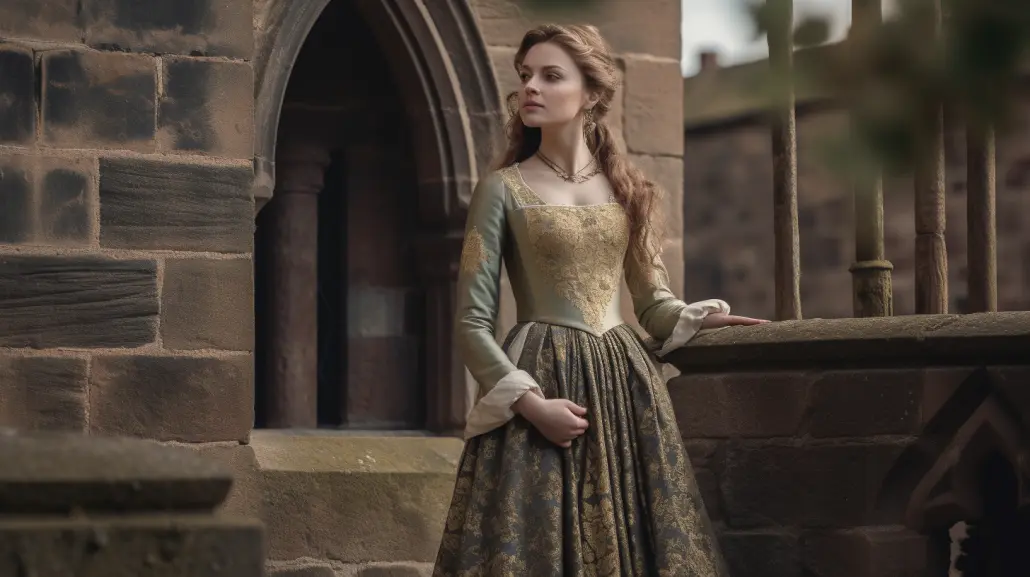
The kirtle was the medieval equivalent of your favorite little black dress. An essential piece in the wardrobe of medieval women, the kirtle was a long dress with a fitted bodice. It could be worn alone or under a more ornate gown, making it a versatile piece that defined medieval women’s fashion.
Surcoats: The Fashionable Overlayer
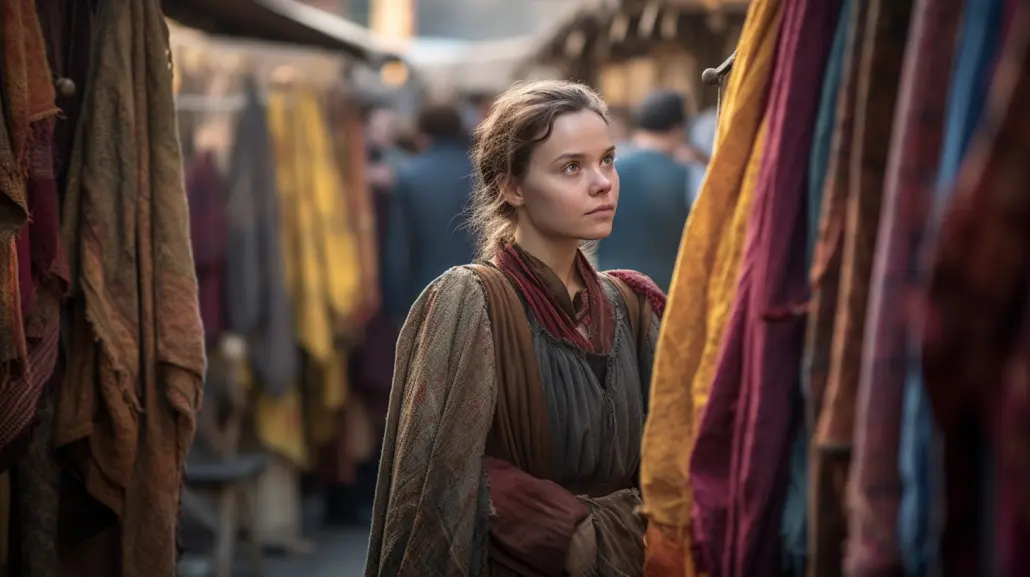
Layering was a huge part of medieval women’s fashion, and surcoats were a great example of this. A surcoat was a sleeveless outer garment worn over the kirtle. For the nobility, surcoats were adorned with embroidery and gemstones, offering a canvas for artistic expression and a symbol of wealth.
The Headdress: The Crown of Medieval Women’s Fashion
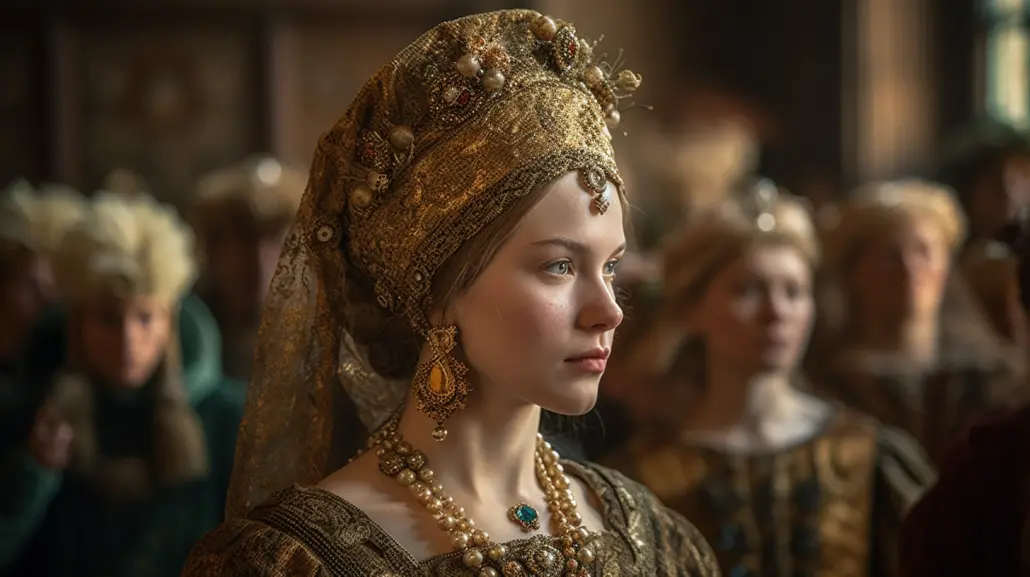
Medieval women’s fashion wasn’t just about the dresses; the headdress also held a place of importance. Ladies would wear a simple linen headdress called a ‘wimple’ or a more elaborate one like the ‘hennin’, which was a tall, conical hat adorned with veils. A woman’s headdress often signified her marital status and social rank.
The Evolution of Medieval Women’s Fashion
Fashion, as we know, is ever-changing, and medieval women’s fashion was no exception. Over the centuries, the cut, fit, and style of dresses evolved dramatically.
The Shift from Loose to Fitted
In the early Middle Ages, the kirtle was a loose, free-flowing garment. But, as we move into the later Middle Ages, the kirtle became more fitted. The ‘cotehardie’, a close-fitted version of the kirtle, came into fashion. With a laced bodice and sleeves that tapered down to a snug fit at the wrists, the cotehardie was a radical departure from earlier styles, reflecting the increasing emphasis on displaying a woman’s figure. This was a game-changer in medieval women’s fashion.
The Introduction of the Houppelande
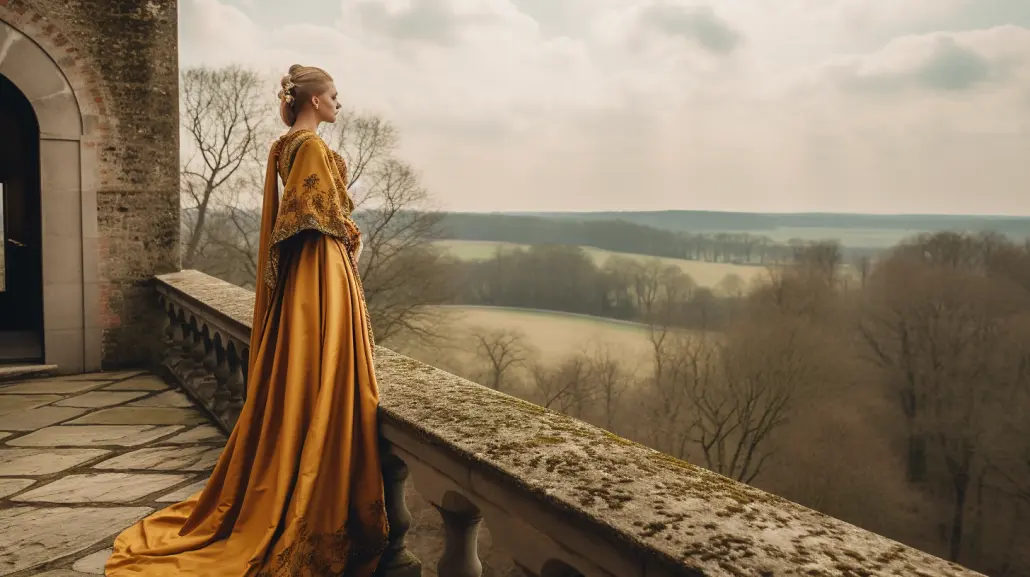
Fashion in the late Middle Ages saw another major shift with the introduction of the ‘houppelande’. This garment, with its high collar, wide sleeves, and a voluminous skirt, was a testament to extravagance. Often made from luxurious fabrics and adorned with fur or velvet, the houppelande was a dramatic piece that offered a stark contrast to the fitted cotehardie. Again, this demonstrated the dynamism of medieval women’s fashion.
The Socio-Cultural Significance of Medieval Women’s Fashion
Medieval women’s fashion was more than just a sartorial choice—it was also a reflection of the societal norms and cultural beliefs of the time.
Status Symbol
Medieval women’s fashion was a language that spoke volumes about a woman’s social status. Sumptuous fabrics, vibrant colors, intricate embroidery, and lavish accessories were reserved for the upper classes, while the lower classes donned simpler, more practical attires.
Fashion and Modesty
Modesty was a central concept in medieval culture, and this was strongly reflected in medieval women’s fashion. Clothing was modest and often covered most of the body. Headdresses, for instance, were worn not just as a fashion statement but also as a sign of modesty, as they covered a woman’s hair.
The Influence of Medieval Women’s Fashion on Modern Fashion
What if I told you that the runway styles you admire have roots in medieval women’s fashion? Intriguing, isn’t it? The influence of medieval fashion has subtly seeped into modern fashion trends. And why not? After all, fashion, like history, tends to repeat itself.
The Medieval Corset and Modern Body Shapers
In the late Middle Ages, women began wearing a garment known as the ‘cotte’ or ‘cote’, which was laced up to cinch the waist and create a more defined silhouette. This could arguably be seen as the predecessor of modern-day body shapers or corsets. So, next time you put on a waist trainer or a body shaper, remember you’re donning a piece of medieval women’s fashion, modernized!
Oversized Sleeves: A Nod to the Houppelande
If you’ve ever worn a top or a dress with oversized, billowing sleeves, then you’ve worn a trend inspired by medieval women’s fashion. The houppelande, with its voluminous sleeves, is an ancestor of the modern oversized sleeve trend that we see on runways today.
The Headgear Inspiration
Those statement-making hats and fascinators we see adorning the heads of modern women? They owe a nod to the elaborate headdresses of medieval times. The ‘hennin’, the tall, conical hat of the late Middle Ages, was a statement piece in its own right. In a way, it set the stage for women to use headgear as a bold fashion statement.
Medieval Women’s Fashion: An Unending Inspiration
Medieval women’s fashion, like a classic novel, is an unending source of inspiration. Designers continually look back to this era to draw ideas and reinterpret them in contemporary fashion. Whether it’s the intricacies of embroidery, the richness of fabrics, or the opulence of ornamentation, elements of medieval women’s fashion continue to resonate in today’s fashion landscape.
The Takeaway: Embrace the Medieval Spirit
By this point, you’re well-versed in the subtleties and significances of medieval women’s fashion. But what’s the takeaway here, you ask?
First and foremost, fashion is not just about wearing clothes—it’s a powerful medium of self-expression and a reflection of the times. Medieval women expressed their identity, social status, and cultural values through their fashion choices, and we continue to do the same today.
Secondly, never underestimate the influence of history on present trends. Medieval women’s fashion has given us some unforgettable style statements, many of which continue to inspire modern fashion.
Finally, always remember the key lesson from medieval women’s fashion: versatility. Just as the medieval women had a versatile wardrobe, from the humble kirtle to the regal houppelande, don’t be afraid to mix up your style. Pair that denim jacket with a flowy maxi dress, or team your leather leggings with a vintage tunic. After all, fashion is all about experimenting, evolving, and expressing your unique style.
So there you have it, ladies—a deep dive into medieval women’s fashion and its timeless appeal. Hopefully, you now have a newfound appreciation for this fascinating era of fashion history. Whether you’re a history buff, a fashionista, or just someone who loves a good story, the world of medieval women’s fashion offers a captivating journey through time, style, and culture.
Summing It Up
To wrap up our fashion journey, it’s clear that medieval women’s fashion was a fascinating realm, rich with variety and meaning. It offered a window into the lives of the women who lived through those centuries, reflecting their social status, cultural norms, and personal styles.
So, next time you’re pulling on your comfy jeans and a t-shirt, remember the ladies of the past who rocked the kirtles and houppelandes. As we’ve seen, the world of medieval women’s fashion was so much more than just clothing—it was a tapestry of history, culture, and art.
For modern fashionistas, there’s a lot to learn from medieval women’s fashion. From the practicality of peasant attire to the lavishness of nobility dresses, from the versatility of kirtles to the flamboyance of houppelandes, medieval women’s fashion offers a blend of simplicity and extravagance that can inspire our own fashion choices.
After all, knowing where we came from can help us understand where we’re going. And in the realm of fashion, the medieval era holds a treasure trove of insights and inspirations. Here’s to the medieval fashionista in all of us!
As we sign off from this remarkable journey, remember, the spirit of medieval women’s fashion isn’t just about the clothes—it’s about expressing yourself, your status, and your beliefs through your attire. So, wear your style with pride, ladies, because every day is a chance to make your own fashion statement!

